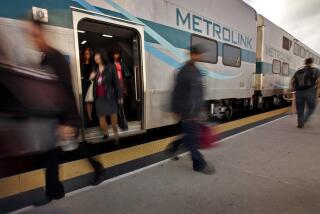Rail Deaths Unavoidable, Officials Say
- Share via
As investigators pieced together details related to a fifth fatality involving a Metrolink train in four months, railroad authorities said Thursday there are few safety measures they can implement to prevent accidents involving people who walk or sit along unguarded tracks.
Said Jacki Bacharach, a member of the Metropolitan Transportation Authority, which oversees Metrolink: “People don’t go sitting on the freeway, and they shouldn’t sit on the tracks.”
Apolinar Arellano, 32, of Sun Valley was struck and killed Wednesday night while sitting on the tracks near San Fernando Road and Sunland Avenue in Sun Valley, police said. The train, traveling at more than 60 m.p.h., had just left Burbank en route to Santa Clarita when it struck Arellano, throwing him about 250 feet.
The train’s engineer also was at the controls of the Metrolink train that hit a dump truck at an unguarded crossing on Nov. 25, killing driver Jaime Farias, 37, of Los Angeles.
Dave Watson, chief investigator for the National Transportation Safety Board, said several national studies on rail accidents have concluded that rail authorities can do little to prevent injuries and fatalities involving pedestrians who wander in front of moving trains.
Even reducing train speed may not prevent accidents, he said, because anecdotal evidence indicates that motorists and pedestrians become impatient with slower trains and may be more likely to try to outrun or skirt around lowered crossing guards.
Although the engineer had reported that he saw Arellano and four other men sitting on the tracks apparently drinking alcohol, police said it is unclear why Arellano did not jump away as the other men did.
“I don’t know if he was unconscious or what,” said Los Angeles Police Lt. Charles Kunz. “Any comment about why he did not get up and run is pure speculation.”
Determination of the official cause of death is awaiting results of an autopsy, which may include a toxicology test, he said.
Peter Hidalgo, a Metrolink spokesman, said that installing a fence or wall along the tracks would be impractical because the system is projected to eventually operate over 400 miles and serve 70 stations, more than three times its present scope--which would necessitate more than 800 miles of barriers.
On the 22-mile Metro Blue Line that connects downtown Los Angeles to Long Beach, there have been seven deaths and 40 injuries in more than 100 accidents since the system debuted in July, 1990. But Hidalgo said that two systems are not comparable because Metrolink uses heavy-rail technology and the Blue Line light rail.
The number of Metrolink-related deaths is not out of line with fatalities involving other heavy-rail lines, such as freight systems, he said.
He also noted that two of the previous deaths involved men who police believe committed suicide by stepping in front of trains and another occurred when a man tripped while trying to outrun a train.
A spokeswoman for Southern Pacific railroad said the only precaution is education. Metrolink officials are participating in Operation Life Saver, a program designed to increase public awareness of the potential dangers around the tracks.
More to Read
Sign up for Essential California
The most important California stories and recommendations in your inbox every morning.
You may occasionally receive promotional content from the Los Angeles Times.











